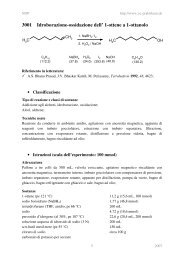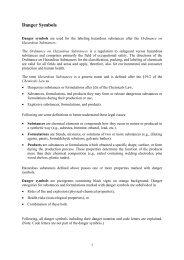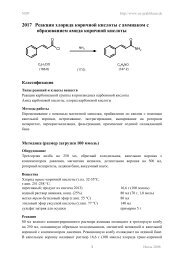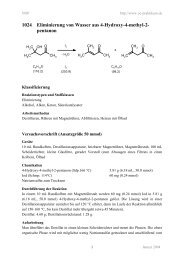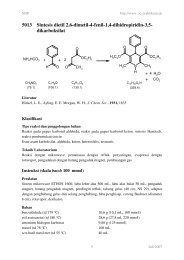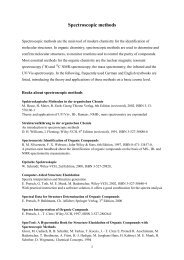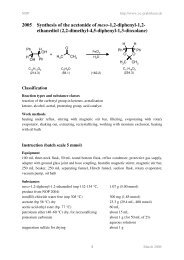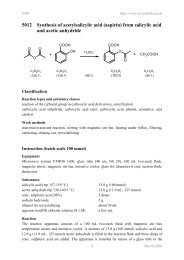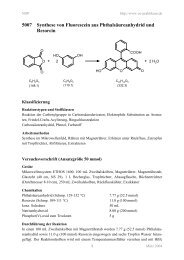Synthesis instructions as PDF file for printing - kriemhild
Synthesis instructions as PDF file for printing - kriemhild
Synthesis instructions as PDF file for printing - kriemhild
You also want an ePaper? Increase the reach of your titles
YUMPU automatically turns print PDFs into web optimized ePapers that Google loves.
NOP http://www.oc-praktikum.de<br />
1017 Azocoupling of benzenediazonium chloride with<br />
2-naphthol to 1-phenylazo-2-naphthol<br />
NH 3<br />
C6H8ClN (129.6)<br />
Cl<br />
C 10 H 8 O<br />
(144.2)<br />
Cl<strong>as</strong>sification<br />
OH<br />
NaNO 2<br />
(69.0)<br />
N<br />
N<br />
Cl<br />
C 6 H 5 ClN 2<br />
(140.6)<br />
Reaction types and substance cl<strong>as</strong>ses<br />
electrophilic substitution of aromatics, azocoupling<br />
aromatics, diazonium salt, naphthol, dye<br />
+<br />
1<br />
N<br />
N<br />
Cl<br />
C 6 H 5 ClN 2<br />
(140.6)<br />
N<br />
C 16 H 12 N 2 O<br />
(248.3)<br />
Work methods<br />
stirring with magnetic stir bar, filtering, recrystallizing, use of an ice cooling bath, heating<br />
with oil bath<br />
batch scale 100 mmol, additional:<br />
stirring with KPG-stirrer, adding dropwise with an addition funnel<br />
Instruction (batch scale 10 mmol)<br />
Equipment<br />
250 mL Erlenmeyer fl<strong>as</strong>k, 100 mL Erlenmeyer fl<strong>as</strong>k, internal thermometer, pipette, heatable<br />
magnetic stirrer, magnetic stir bar, suction fl<strong>as</strong>k, Büchner funnel, desiccator, ice bath, oil bath<br />
N<br />
OH<br />
March 2006
NOP http://www.oc-praktikum.de<br />
Substances<br />
aniline hydrochloride (mp 199-202 °C) 1.43 g (11.0 mmol)<br />
2-naphthol (mp 122-123 °C) 1.44 g (10.0 mmol)<br />
sodium nitrite 759 mg (11.0 mmol)<br />
conc. hydrochloric acid (35%) 2.5 mL<br />
aqueous sodium hydroxide solution (1 M) 40 mL<br />
ethanol <strong>for</strong> recrystallizing about 50 mL<br />
urea small amount<br />
pot<strong>as</strong>sium iodide starch test strips<br />
ice<br />
Reaction<br />
Preparation of the diazonium salt solution:<br />
13 g ice, 5 mL water and 2.5 mL conc. hydrochloric acid are filled in a 100 mL Erlenmeyer<br />
fl<strong>as</strong>k with magnetic stir bar and internal thermometer. To this mixture 1.43 g (11.0 mmol)<br />
aniline hydrochloride are added. Under ice cooling and stirring and at an internal temperature<br />
of 0-5 °C so much from a solution of 759 mg (11.0 mmol) sodium nitrite in 3 mL water<br />
(about 2.5 mL) is added slowly by using a pipette, that an excess of nitric acid is avoided. The<br />
test <strong>for</strong> HNO2 is carried out with pot<strong>as</strong>sium iodide starch test strips by dropping a sample of<br />
the reaction solution with a pipette on a test strip. A blue coloured paper shows HNO2. So<br />
much sodium nitrite solution is added, that a proof is positive still 5 minutes after the l<strong>as</strong>t<br />
addition of nitrite. Excessive nitric acid is removed by addition of a small amount of urea.<br />
Azocoupling:<br />
1.44 g (10.0 mmol) 2-naphthol are dissolved in 40 mL 1 M sodium hydroxide solution in a<br />
250 mL Erlenmeyer fl<strong>as</strong>k. The solution is cooled. Under strong stirring and ice cooling the ice<br />
cooled benzenediazonium salt solution is added in portions. Towards the end of addition the<br />
pH value of the solution is controlled. To keep the solution in the alkaline range, a 1 M<br />
sodium hydroxide solution is added dropwise by means of a pipette, if necessary. After the<br />
addition is finished, the mixture is stirred <strong>for</strong> 30 minutes at 0-5 °C.<br />
Work up<br />
The orange precipitated product is sucked off over a Buechner funnel and repeatedly w<strong>as</strong>hed<br />
with water. The product is dried in the vacuum desiccator until weight constancy. According<br />
to the vacuum and drying agent, the drying procedure can l<strong>as</strong>t up to a few days.<br />
Crude yield (humid): 6.5 g<br />
Crude yield (dry): 2.20 g; mp 129 °C<br />
The crude product is recrystallized from about 50 mL ethanol and then dried in the vacuum<br />
desiccator.<br />
Yield: 1.97 g (7.93 mmol, 79%); mp 134 °C<br />
2<br />
March 2006
NOP http://www.oc-praktikum.de<br />
W<strong>as</strong>te management<br />
Recycling<br />
The ethanol from the mother liquor is evaporated, collected and redistilled.<br />
W<strong>as</strong>te disposal<br />
W<strong>as</strong>te Disposal<br />
aqueous filtrate solvent water mixtures,containing halogen<br />
residue from the mother liquor dissolve in a small amount of acetone, then:<br />
organic solvents, halogen free<br />
Time<br />
4 hours, without time <strong>for</strong> drying<br />
Break<br />
Be<strong>for</strong>e recrystallization<br />
Degree of difficulty<br />
Medium<br />
Instruction (batch scale 100 mmol)<br />
Equipment<br />
250 mL Erlenmeyer fl<strong>as</strong>k, 1 L beaker, internal thermometer, addition funnel, heatable<br />
magnetic stirrer, magnetic stir bar, KPG-stirrer, suction fl<strong>as</strong>k, Buechner funnel, desiccator, ice<br />
bath, oil bath<br />
Substances<br />
aniline hydrochloride (mp 199-202 °C) 14.3 g (110 mmol)<br />
2-naphthol (mp 122-123 °C) 14.4 g (100 mmol)<br />
sodium nitrite 7.59 g (110 mmol)<br />
conc. hydrochloric acid (35%) 25 mL<br />
aqueous sodium hydroxide solution (1 M) 400 mL<br />
ethanol <strong>for</strong> recrystallizing about 500 mL<br />
urea small amount<br />
pot<strong>as</strong>sium iodide starch test strips<br />
ice<br />
Reaction<br />
Preparation of the diazonium salt solution:<br />
130 g ice, 50 mL water and 25 mL conc. hydrochloric acid are filled in a 100 mL Erlenmeyer<br />
fl<strong>as</strong>k with magnetic stir bar and internal thermometer. To this mixture 14.3 g (110 mmol)<br />
aniline hydrochloride are added. Under ice cooling and stirring and at an internal temperature<br />
of 0-5 °C so much from a solution of 7.59 g (110 mmol) sodium nitrite in 3 mL water (about<br />
25 mL) is added slowly dropwise with an addition funnel, that an excess of nitric acid is<br />
3<br />
March 2006
NOP http://www.oc-praktikum.de<br />
avoided. The test <strong>for</strong> HNO2 is carried out with pot<strong>as</strong>sium iodide starch test strips by dropping<br />
a sample of the reaction solution with a pipette on a test strip. A blue coloured paper shows<br />
HNO2. So much sodium nitrite solution is added, that a proof is positive still 5 minutes after<br />
the l<strong>as</strong>t addition of nitrite. Excessive nitric acid is removed by addition of a small amount of<br />
urea.<br />
Azocoupling:<br />
14.4 g (100 mmol) 2-naphthol are dissolved in 400 mL 1 M sodium hydroxide solution in a 1<br />
L beaker. The solution is cooled. Under strong stirring with a KPG-stirrer and ice cooling the<br />
ice cooled benzenediazonium salt solution is added slowly in portions. Towards the end of the<br />
addition the pH-value is checked. To keep the solution in the alkaline range, a 1 M sodium<br />
hydroxide solution is added dropwise by means of a pipette, if necessary. After the addition<br />
w<strong>as</strong> finished, the mixture is stirred <strong>for</strong> 30 minutes at 0-5 °C.<br />
Work up<br />
The orange precipitated product is sucked off over a Buechner funnel and then w<strong>as</strong>hed with<br />
500 mL water in a 1 L beaker. The product is again sucked off strongly and then dried in a<br />
vacuum desiccator until weight constancy. According to the vacuum and drying agent, the<br />
drying procedure can l<strong>as</strong>t up to a few days.<br />
Crude yield (humid):160 g<br />
Crude yield (dry): 21.5 g; mp 129 °C<br />
The crude product is recrystallized from 500 mL ethanol and dried in the vacuum desiccator.<br />
Yield: 19.5 g (78.5 mmol, 79%); mp 134 °C<br />
W<strong>as</strong>te management<br />
Recycling<br />
The ethanol from the mother liquor is evaporated, collected and redistilled.<br />
W<strong>as</strong>te disposal<br />
W<strong>as</strong>te Disposal<br />
aqueous filtrate solvent water mixtures, containing halogen<br />
residue from the mother liquor dissolve in a small amount of acetone, then:<br />
organic solvents, halogen free<br />
Time<br />
5-6 hours, without time <strong>for</strong> drying<br />
Break<br />
Be<strong>for</strong>e recrystallization<br />
Degree of difficulty<br />
Medium<br />
4<br />
March 2006
NOP http://www.oc-praktikum.de<br />
Analytics<br />
TLC<br />
TLC-conditions:<br />
adsorbant: Macherey and Nagel Polygram SilG/UV foil, 0.2 mm<br />
eluent: cyclohexane/acetic acid ethyl ester 8:2<br />
Rf (1-phenylazo-2-naphthol) 0.65<br />
Rf (2-naphthol) 0.39<br />
Traces of not reacted 2-naphthol can be detected in the crude product, and also in the mother liquor from the<br />
recrystallization.<br />
GC<br />
GC-conditions:<br />
column: ZB–1, 7 HM–G001-11, length 30 m, internal diameter 0.32 mm, film 0.25 µm<br />
inlet: injector temperature 210 °C, split injection, injected volume 1 µL<br />
carrier g<strong>as</strong>: H2, pre-column pressure 50 kPa<br />
oven: 70 °C (2 min), heating rate 10 °C/min, isotherme 300 °C (10 min)<br />
detector: FID, 310 °C<br />
integrator: Shimadzu<br />
Percent concentration w<strong>as</strong> calculated from peak are<strong>as</strong>.<br />
GC of the product (not recrystallized)<br />
Retention time (min) Substance Peak area %<br />
17.9 product (1-phenylazo-2-naphthol) > 99<br />
from 20 impurities<br />
5<br />
March 2006
NOP http://www.oc-praktikum.de<br />
IR spectrum of the pure product (KBr)<br />
(cm -1 ) Assignment<br />
3400 O-H-valence<br />
3040 C-H-valence, arene<br />
1620 C=C-valence, arene<br />
UV Spectrum (ethanol)<br />
λmax = 422 nm, log ε = 4.05<br />
λmax = 478 nm, log ε = 4.17<br />
6<br />
March 2006



